|
||||||||||
|
|
||||||||||
|
||||||||||
|
|
||||||||||
The biggest driver behind the overall design of the JSF is affordability. The military needs to purchase a large quantity of this class of aircraft to complement larger and more capable planes like the F-22 and F-18E/F Super Hornet that are too expensive to buy in large quantities.
It is these two factors--its mission as a ground attack platform and the need for low cost--that largely dictate the size, layout, and weapons carriage capabilities of the F-35.
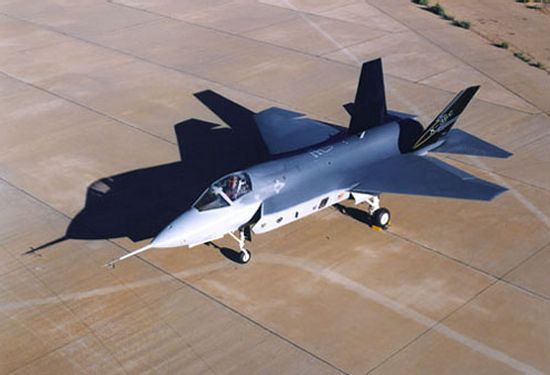
Since the F-35 is primarily intended to be a replacement for the F-16, it is not surprising that the JSF is of roughly the same overall dimensions as the older craft. The F-22, by comparison, is much larger and comparable in size to the F-15 that it was designed to replace. The overall sizes of the F-16, F-22, and the conventional takeoff and landing (CTOL) version of the F-35 that will be purchased by the US Air Force are compared below.
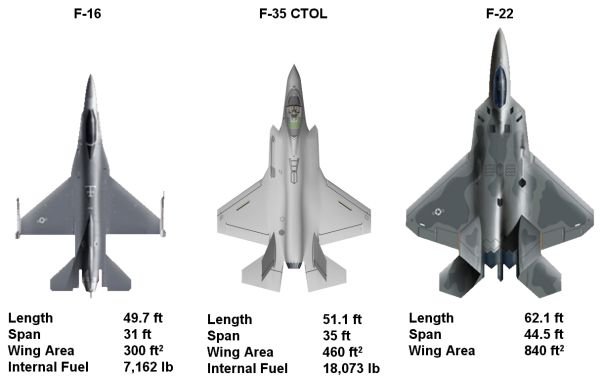
It is also not surprising that the weapons to be carried by both the F-35 and F-22 are comparable to those carried by the F-16 and F-15, respectively. Both the F-15 and F-22 were designed primarily for air-to-air combat and feature a corresponding weapons load of air-to-air missiles. As discussed in a previous question about the F-22 weapons carriage capacity, the aircraft is equipped with four internal bays. Two small side bays are designed for the short-range AIM-9M Sidewinder air-to-air missile while the two center bays were each sized around three medium-range AIM-120C AMRAAM missiles. The F-35, being a much smaller aircraft, has only two center bays. The location and size of these two bays, as well as six external wing pylons, can be seen in the following image. The diagram compares the weapons stations on the CTOL and largely identical short takeoff and landing (STOVL) variants of the JSF versus the carrier-based (CV) model that has a larger wing. Note that the bays of the F-35B STOVL variant were redesigned in late 2004 and are now 14 inches shorter, and perhaps reduced in width, compared to the F-35A CTOL model. This decision was made to reduce the weight of the F-35B in order to meet more important performance goals. Otherwise, the following diagram remains accurate.
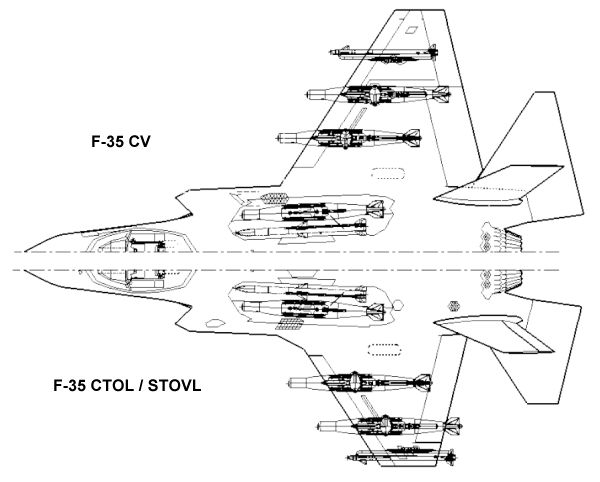
Compared to the JSF, the F-22 Raptor is indeed larger in size and internal volume. Nevertheless, the F-22 suffers from one key limitation. Its center bays were designed around the AIM-120 AMRAAM that is only about 12 ft (3.65 m) in length and has a maximum fin span of about 1.5 ft (0.45 m). These dimensions are quite sufficient for the aircraft's primary role as an air superiority fighter. However, the end of the Cold War forced the Air Force to change priorities and give the F-22 a stronger ground attack capability. Unfortunately, most air-to-ground weapons are significantly longer, wider, taller, and heavier than the AIM-120, making it difficult to integrate such weapons into the F-22 bays. The only weapon that has been integrated so far is the GBU-32 JDAM, a GPS-guided bomb that is about 10 ft (3.05 m) in length and is based on the 1,000 lb (455 kg) Mk-83 general purpose bomb.
Most air-to-surface weapons are in the 2,000-lb (910 kg) class, however, but these weapons are usually around 12.5 to 14 ft (3.80 to 4.25 m) long and too large to fit within the F-22. Bearing these limitations in mind, JSF designers purposefully sized the two internal bays around these larger 2,000-lb class weapons. The two weapons that have predominantly dictated the overall length and depth of the bays are the AGM-154 JSOW and the GBU-31 2,000 lb (910 kg) version of JDAM.
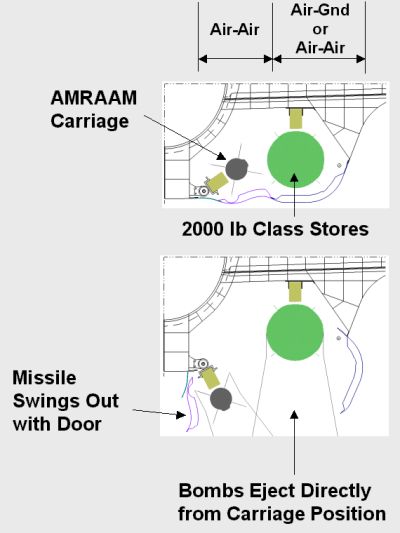
Each bay contains two weapons stations, as shown above. Air-to-ground stores like JSOW and JDAM are carried on the outboard station. Air-to-air weapons can also be carried in this position but are carried primarily on the inboard station that is specifically dedicated to that purpose. One of the unique features of the design is that the air-to-air station swings out on a hinged rail as the inboard bay door opens.
The list of weapons that the JSF will carry when it enters service has not yet been finalized. However, it has been decided that all variants will be cleared to carry the same selection of weapons regardless of whether or not each user actually intends to arm its planes with that weapon. For example, the Navy CV variant will be cleared to carry the Wind Corrected Munitions Dispenser (WCMD) even though only the Air Force has that weapon in its inventory. Similarly, all US aircraft will be compatible with the ASRAAM air-to-air missile that only the United Kingdom plans to carry on its planes. The decision to clear all variants with the same weapon loads was made in order to simplify integration requirements, maintain commonality, and lower overall development costs. Note that the above statements are no longer entirely true since the bays of the F-35B STOVL version have been reduced in size as mentioned earlier. As a result, the F-35B is no longer compatible with JSOW and 2,000 lb JDAM weapons. The largest weapon this F-35 variant can carry internally is the GBU-32 1,000 lb version of JDAM. A list of the weapons that are currently planned for internal carriage on the F-35 is shown below.
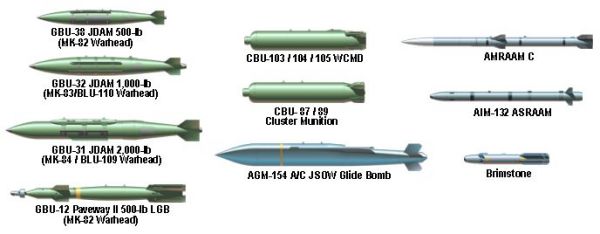
Not included in this diagram are weapons in source selection as of this writing that are to be added to the internal carriage list. These weapons include the American GBU-39 Small Diameter Bomb, of which four can be carried on the air-to-ground station in each bay, and a new 500 lb laser guided bomb for the British (ultimately won by the Paveway IV). Another possible addition is a new variant of JDAM being considered by the US that will add a digital scene matching capability for improved accuracy.
The F-35 also has six external pylons, three under each wing. The inboard station is designed for up to 5,000 lb (2,265 kg) loads and will most likely be used to carry external fuel tanks. The pylon can carry 2000-lb class air-to-ground weapons as well. The midboard pylon is also primarily intended for air-to-ground weapons and can carry up to 2,500 lb (1,135 kg). The surface attack weapons compatible with these two pylons include many of the same ones carried internally as well as additional stores that are too large to fit in the bays. The outboard station on each wing, however, is a dedicated air-to-air station carrying up to 300 lb (135 kg) and designed specifically for short-range infrared guided missiles like AIM-9X Sidewinder. A list of weapons currently planned for external carriage is illustrated below. Note that training bombs have not been included in this list.
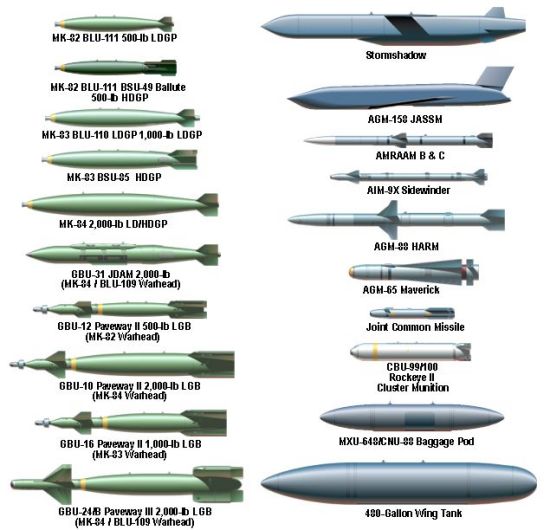
You also ask about whether the aircraft has a gun, and the answer depends on what variant you ask about. The Air Force's CTOL model is the only version carrying an internal gun. The GAU-12 25-mm cannon is mounted above the engine inlet on the left side of the plane, as shown in the diagram below.
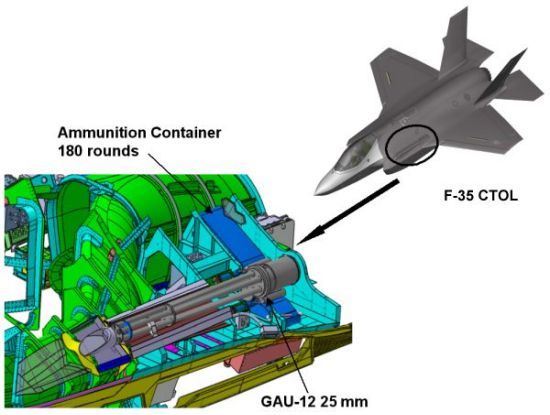
The Navy and Marines, meanwhile, have both opted for a specialized external gun pod on their CV and STOVL variants. The same GAU-12 cannon is carried, but in a special tear-drop pod that can be mounted on a dedicated centerline pylon between the aft portion of the weapons bays. The pod is unique in that it employs stealth characteristics and should allow the aircraft to maintain low observability. Other advantages of the gun pod include room for a larger ammunition supply and the ability to remove the pod on missions where a gun is not necessary.
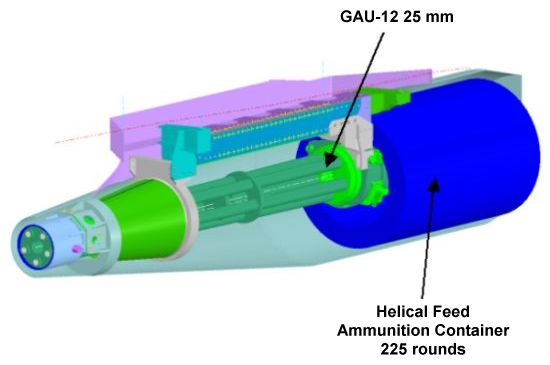
A number of sources indicate that the Mauser BK27 27-mm cannon will be carried on the F-35 instead of the GAU-12, but this information is inaccurate. The BK27 is commonly used on European fighters and was the leading candidate to be integrated aboard the JSF. Rights to manufacture the BK27 in the US had been sold to the Ordnance Division of Boeing, a division that is now part of Alliant Techsystems (ATK). The subcontract to develop a cannon for the F-35 became a competition between the BK27 offered by ATK and the GAU-12 manufactured by General Dynamics Armament and Technical Products (GDATP). The GAU-12 was eventually named the winner of the contract, but the decision is not without controversy as most observers feel the BK27 is the superior choice.
The information we gave gathered here is the latest available, but bear in mind that the Joint Strike Fighter design has not yet been finalized. The wish list of weapons that the various services originally asked to be put on the aircraft was enormous and would require tremendous time and cost to fulfill. As a result, the requirements are still under review, and the list has already been pared down significantly to focus on the most critically needed weapons.
Already eliminated from the list of internally carried stores are older unguided weapons like the Mk 82/83/84 general purpose bombs since it is very unlikely that the services would need to send the plane on a stealthy mission while carrying such archaic weapons. External stores that have been eliminated, or at least postponed, include the AGM-84 Harpoon and SLAM-ER, UK laser guided bombs, rocket pods, mines, and various data link, ECM and reconnaissance pods. Maverick and HARM may also be dropped because they do not currently comply with standard 1760 interface requirements.
Also note that production plans for the Joint Common Missile were cancelled in late 2004, and this weapon will
no longer be carried by the F-35. Furthermore, the Navy has decided not to purchase JASSM, and it seems likely the
Navy would want to integrate SLAM-ER onto the F-35 in its place.
- answer by Jeff Scott, 16 February 2004
Related Topics:
Read More Articles:


|
Aircraft | Design | Ask Us | Shop | Search |

|
|
| About Us | Contact Us | Copyright © 1997-2023 | |||
|
|
|||